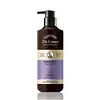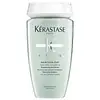Dr. Groot Multi-Perfection Hair Loss Care Shampoo Versus Kérastase Specifique Bain Divalent Balancing Shampoo
What's inside
What's inside
 Key Ingredients
Key Ingredients

 Benefits
Benefits

 Concerns
Concerns

 Ingredients Side-by-side
Ingredients Side-by-side

Water
Skin ConditioningDisodium Laureth Sulfosuccinate
CleansingLauryl Hydroxysultaine
CleansingPotassium Cocoyl Glycinate
Glycerin
HumectantCocamide Methyl Mea
Sodium Chloride
MaskingAdenosine
Skin ConditioningEscin
TonicBiotin
AntiseborrhoeicHydrolyzed Collagen
EmollientCaffeine
Skin ConditioningHyaluronic Acid
HumectantSaccharomyces Cerevisiae Extract
Skin ConditioningGlycine Soja Oil
EmollientRetinol
Skin ConditioningRhus Semialata Gall Extract
Skin ConditioningDioscorea Japonica Root Extract
Skin ConditioningGlycyrrhiza Glabra Root Extract
BleachingCentella Asiatica Leaf Extract
Skin ConditioningPanax Ginseng Root Extract
EmollientTypha Angustifolia Spike Extract
Skin ConditioningCinnamomum Cassia Bark Extract
MaskingPaeonia Lactiflora Root Extract
Skin ConditioningLithospermum Erythrorhizon Root Extract
Skin ConditioningPopulus Nigra Bark/Bud/Leaf/Twig Extract
Skin ConditioningOphiopogon Japonicus Root Extract
Skin ConditioningSalvia Miltiorrhiza Root Extract
Skin ConditioningScutellaria Baicalensis Root Extract
AstringentAtractylodes Japonica Rhizome Extract
Skin ConditioningGlycine Max Seed Extract
Skin ConditioningOryza Sativa Bran Extract
Skin ConditioningSaposhnikovia Divaricata Root Extract
AntimicrobialSesamum Indicum Seed Extract
Skin ConditioningZingiber Officinale Root Extract
MaskingZiziphus Jujuba Fruit Extract
Skin ConditioningAngelica Gigas Root Extract
Skin ConditioningGlycine
BufferingSerine
MaskingGlutamic Acid
HumectantAspartic Acid
MaskingLeucine
Skin ConditioningAlanine
MaskingLysine
Skin ConditioningArginine
MaskingTyrosine
MaskingPhenylalanine
MaskingProline
Skin ConditioningThreonine
Valine
MaskingIsoleucine
Skin ConditioningHistidine
HumectantCysteine
AntioxidantMethionine
Skin ConditioningMenthol
MaskingPanthenol
Skin ConditioningSalicylic Acid
MaskingNiacinamide
SmoothingPolyquaternium-7
Glyceryl Oleate
EmollientPolyquaternium-22
Dicaprylyl Carbonate
EmollientPEG-Crosspolymer
Acrylamidopropyltrimonium Chloride/Acrylates Copolymer
Sodium Cocoyl Isethionate
CleansingCoco-Glucoside
CleansingTetrasodium EDTA
Citric Acid
BufferingCaramel
Cosmetic ColorantPEG-40 Hydrogenated Castor Oil
EmulsifyingPEG-150 Pentaerythrityl Tetrastearate
EmulsifyingPPG-2 Hydroxyethyl Cocamide
EmulsifyingButylene Glycol
HumectantAminomethyl Propanol
BufferingHexylene Glycol
EmulsifyingAlcohol Denat.
AntimicrobialPentylene Glycol
Skin ConditioningPropanediol
SolventTocopherol
AntioxidantHydrogenated Lecithin
EmulsifyingZein
Skin ConditioningCholesterol
EmollientSorbitan Oleate
EmulsifyingEthylhexylglycerin
Skin Conditioning1,2-Hexanediol
Skin ConditioningCaprylyl Glycol
EmollientSodium Benzoate
MaskingParfum
MaskingLimonene
PerfumingLinalool
PerfumingHydroxycitronellal
PerfumingCitronellol
PerfumingWater, Disodium Laureth Sulfosuccinate, Lauryl Hydroxysultaine, Potassium Cocoyl Glycinate, Glycerin, Cocamide Methyl Mea, Sodium Chloride, Adenosine, Escin, Biotin, Hydrolyzed Collagen, Caffeine, Hyaluronic Acid, Saccharomyces Cerevisiae Extract, Glycine Soja Oil, Retinol, Rhus Semialata Gall Extract, Dioscorea Japonica Root Extract, Glycyrrhiza Glabra Root Extract, Centella Asiatica Leaf Extract, Panax Ginseng Root Extract, Typha Angustifolia Spike Extract, Cinnamomum Cassia Bark Extract, Paeonia Lactiflora Root Extract, Lithospermum Erythrorhizon Root Extract, Populus Nigra Bark/Bud/Leaf/Twig Extract, Ophiopogon Japonicus Root Extract, Salvia Miltiorrhiza Root Extract, Scutellaria Baicalensis Root Extract, Atractylodes Japonica Rhizome Extract, Glycine Max Seed Extract, Oryza Sativa Bran Extract, Saposhnikovia Divaricata Root Extract, Sesamum Indicum Seed Extract, Zingiber Officinale Root Extract, Ziziphus Jujuba Fruit Extract, Angelica Gigas Root Extract, Glycine, Serine, Glutamic Acid, Aspartic Acid, Leucine, Alanine, Lysine, Arginine, Tyrosine, Phenylalanine, Proline, Threonine, Valine, Isoleucine, Histidine, Cysteine, Methionine, Menthol, Panthenol, Salicylic Acid, Niacinamide, Polyquaternium-7, Glyceryl Oleate, Polyquaternium-22, Dicaprylyl Carbonate, PEG-Crosspolymer, Acrylamidopropyltrimonium Chloride/Acrylates Copolymer, Sodium Cocoyl Isethionate, Coco-Glucoside, Tetrasodium EDTA, Citric Acid, Caramel, PEG-40 Hydrogenated Castor Oil, PEG-150 Pentaerythrityl Tetrastearate, PPG-2 Hydroxyethyl Cocamide, Butylene Glycol, Aminomethyl Propanol, Hexylene Glycol, Alcohol Denat., Pentylene Glycol, Propanediol, Tocopherol, Hydrogenated Lecithin, Zein, Cholesterol, Sorbitan Oleate, Ethylhexylglycerin, 1,2-Hexanediol, Caprylyl Glycol, Sodium Benzoate, Parfum, Limonene, Linalool, Hydroxycitronellal, Citronellol
Water
Skin ConditioningSodium Laureth Sulfate
CleansingTea-Lauryl Sulfate
CleansingCocamide Mipa
EmulsifyingDisodium Cocoamphodiacetate
CleansingGlycol Distearate
EmollientHexylene Glycol
EmulsifyingSodium Chloride
MaskingCitric Acid
BufferingSodium Benzoate
MaskingSodium Hydroxide
BufferingCapryloyl Glycine
CleansingPolyquaternium-11
Salicylic Acid
MaskingCarbomer
Emulsion StabilisingPyridoxine Hcl
Skin ConditioningMenthoxypropanediol
MaskingGuar Hydroxypropyltrimonium Chloride
Skin ConditioningHexyl Cinnamal
PerfumingLinalool
PerfumingHydroxycitronellal
PerfumingCitronellol
PerfumingBenzyl Alcohol
PerfumingFumaric Acid
BufferingParfum
MaskingWater, Sodium Laureth Sulfate, Tea-Lauryl Sulfate, Cocamide Mipa, Disodium Cocoamphodiacetate, Glycol Distearate, Hexylene Glycol, Sodium Chloride, Citric Acid, Sodium Benzoate, Sodium Hydroxide, Capryloyl Glycine, Polyquaternium-11, Salicylic Acid, Carbomer, Pyridoxine Hcl, Menthoxypropanediol, Guar Hydroxypropyltrimonium Chloride, Hexyl Cinnamal, Linalool, Hydroxycitronellal, Citronellol, Benzyl Alcohol, Fumaric Acid, Parfum
 Reviews
Reviews

Ingredients Explained
These ingredients are found in both products.
Ingredients higher up in an ingredient list are typically present in a larger amount.
Citric Acid is an alpha hydroxy acid (AHA) naturally found in citrus fruits like oranges, lemons, and limes.
Like other AHAs, citric acid can exfoliate skin by breaking down the bonds that hold dead skin cells together. This helps reveal smoother and brighter skin underneath.
However, this exfoliating effect only happens at high concentrations (20%) which can be hard to find in cosmetic products.
Due to this, citric acid is usually included in small amounts as a pH adjuster. This helps keep products slightly more acidic and compatible with skin's natural pH.
In skincare formulas, citric acid can:
While it can provide some skin benefits, research shows lactic acid and glycolic acid are generally more effective and less irritating exfoliants.
Most citric acid used in skincare today is made by fermenting sugars (usually from molasses). This synthetic version is identical to the natural citrus form but easier to stabilize and use in formulations.
Read more about some other popular AHA's here:
Learn more about Citric AcidCitronellol is used to add fragrance/parfum to a product. It is often derived from plants such as roses. In fact, it can be found in many essential oils including geranium, lavender, neroli, and more. The scent of Citronellol is often described as "fresh, grassy, and citrus-like".
Since the Citronellol molecule is already unstable, Citronellol becomes irritating on the skin when exposed to air.
Citronellol is a modified terpene. Terpenes are unsaturated hydrocarbons found in plants. They make up the primary part of essential oils.
Citronellol is not able to be absorbed into deeper layers of the skin. It has low permeability,
Citronellol is also a natural insect repellent.
Learn more about CitronellolHexylene Glycol is a surfactant. Glycols are a class of alcohols. Hexylene Glycol is a surfactant and emulsifier.
As a surfactant, Hexylene Glycol helps gather dirt and oil on your skin to be washed away.
As an emulsifier, Hexylene Glycol helps keep water and oil together. This prevents them from separating in a product. Hexylene Glycol also thins out the texture of a product by lessening viscosity.
Hexylene Glycol has a small molecular weight.
Learn more about Hexylene GlycolHydroxycitronellal is a fragrance created from citronellal. The smell of hydroxycitronellal is often described as "citrus-like" or "melon-like".
Hydroxycitronellal is a known EU allergen and may cause irritation when applied to the skin.
Linalool is a fragrance and helps add scent to products. It's derived from common plants such as cinnamon, mint, citrus, and lavender.
Like Limonene, this ingredient oxidizes when exposed to air. Oxidized linalool can cause allergies and skin sensitivity.
This ingredient has a scent that is floral, spicy tropical, and citrus-like.
Learn more about LinaloolParfum is a catch-all term for an ingredient or more that is used to give a scent to products.
Also called "fragrance", this ingredient can be a blend of hundreds of chemicals or plant oils. This means every product with "fragrance" or "parfum" in the ingredients list is a different mixture.
For instance, Habanolide is a proprietary trade name for a specific aroma chemical. When used as a fragrance ingredient in cosmetics, most aroma chemicals fall under the broad labeling category of “FRAGRANCE” or “PARFUM” according to EU and US regulations.
The term 'parfum' or 'fragrance' is not regulated in many countries. In many cases, it is up to the brand to define this term.
For instance, many brands choose to label themselves as "fragrance-free" because they are not using synthetic fragrances. However, their products may still contain ingredients such as essential oils that are considered a fragrance by INCI standards.
One example is Calendula flower extract. Calendula is an essential oil that still imparts a scent or 'fragrance'.
Depending on the blend, the ingredients in the mixture can cause allergies and sensitivities on the skin. Some ingredients that are known EU allergens include linalool and citronellol.
Parfum can also be used to mask or cover an unpleasant scent.
The bottom line is: not all fragrances/parfum/ingredients are created equally. If you are worried about fragrances, we recommend taking a closer look at an ingredient. And of course, we always recommend speaking with a professional.
Learn more about ParfumSalicylic Acid (also known as beta hydroxy acid or BHA) is a well-known ingredient for treating skin that struggles with acne and clogged pores. It exfoliates both the skin's surface and deep within the pores to help clear out buildup, control oil, and reduce inflammation.
Unlike AHAs (alpha hydroxy acids), salicylic acid is oil-soluble. This allows it to penetrate into pores which makes it especially effective for treating blackheads and preventing future breakouts.
Salicylic acid is also known for its soothing properties. It has a similar structure to aspirin and can calm inflamed or irritated skin, making it a good option for acne-prone skin that is also sensitive.
Concentrations of 0.5-2% are recognized by the U.S. FDA as an over-the-counter topical acne product.
It can cause irritation and/or dryness if one's skin already has a compromised moisture barrier, so it's best to focus on repairing that before introducing this ingredient into your routine.
While salicylic acid does not increase sun sensitivity, it’s still important to wear sunscreen daily to protect your skin.
If you are looking for the ingredient called BHA or Butylated Hydroxyanisole, click here.
Learn more about Salicylic AcidSodium Benzoate is a preservative. It's used in both cosmetic and food products to inhibit the growth of mold and bacteria. It is typically produced synthetically.
Both the US FDA and EU Health Committee have approved the use of sodium benzoate. In the US, levels of 0.1% (of the total product) are allowed.
Sodium benzoate works as a preservative by inhibiting the growth of bacteria inside of cells. It prevents the cell from fermenting a type of sugar using an enzyme called phosphofructokinase.
It is the salt of benzoic acid. Foods containing sodium benzoate include soda, salad dressings, condiments, fruit juices, wines, and snack foods.
Studies for using ascorbic acid and sodium benzoate in cosmetics are lacking, especially in skincare routines with multiple steps.
We always recommend speaking with a professional, such as a dermatologist, if you have any concerns.
Learn more about Sodium BenzoateChances are, you eat sodium chloride every day. Sodium Chloride is also known as table salt.
This ingredient has many purposes in skincare: thickener, emulsifier, and exfoliator.
You'll most likely find this ingredient in cleansers where it is used to create a gel-like texture. As an emulsifier, it also prevents ingredients from separating.
There is much debate on whether this ingredient is comedogenic. The short answer - comedogenic ratings don't tell the whole story. Learn more about comegodenic ratings here.
The concensus about this ingredient causing acne seems to be divided. Research is needed to understand if this ingredient does cause acne.
Scrubs may use salt as the primary exfoliating ingredient.
Learn more about Sodium ChlorideWater. It's the most common cosmetic ingredient of all. You'll usually see it at the top of ingredient lists, meaning that it makes up the largest part of the product.
So why is it so popular? Water most often acts as a solvent - this means that it helps dissolve other ingredients into the formulation.
You'll also recognize water as that liquid we all need to stay alive. If you see this, drink a glass of water. Stay hydrated!
Learn more about Water